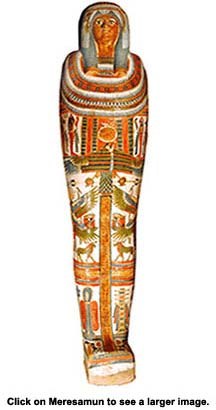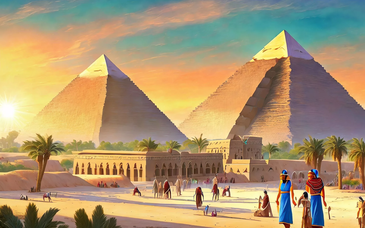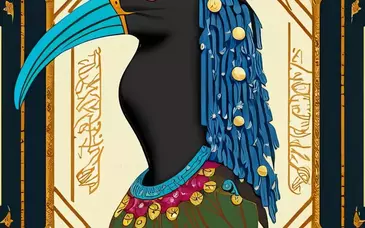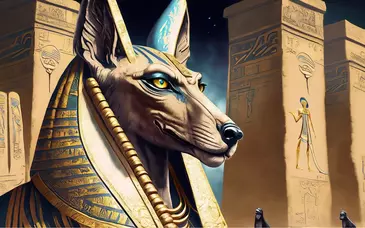Mummy and Coffin of Meresamun
Cartonnage, pigment, human remains
Third Intermediate Period, Dynasty 22, ca. 946-712 B.C.
Purchased in Luxor, 1920
OIM 10797

This colorful cartonnage mummy case, which still contains the mummy of an ancient Egyptian woman, is inscribed with the name Meresamun ("She lives for Amun"). Where Meresamun lived and died is unknown, although the style of the coffin suggests that she was originally from the Theban (modern Luxor) area. According to the inscription, she held the title "Singer in the Interior of the Temple of Amun," a high position in the bureaucracy of priestesses.
Her coffin is painted with scenes which were intended to ensure Meresamun’s successful rebirth into the afterlife. The head of the coffin is decorated with a headband of flower petals with wings of a protective vulture by each cheek, and a small vulture head on the forehead. This type of headgear was worn by queens, priestesses, and goddesses. Over the chest are layers of wide floral necklaces which were symbols of regeneration. Below the floral collars, right and left, are two pairs of gods who were entrusted with the protection of the internal organs that were removed during the mummification process. To the right are the hawk-headed god, Quebehsenuef, who guarded the intestines, and the jackal-headed Duamutef, who guarded the stomach. To the left is the human-form Imseti, who guarded the liver, and the ape-headed Hapy, who guarded the lungs. Between and slightly below these gods is a large representation of the falcon god Horus (or, perhaps, Re), with the sun’s disk on his head, clasping a round shen ("eternity") sign in each talon. A feather fan, a symbol of divinity emerges from each shen sign. The solar Horus, as a symbol of the eternally reborn sun, signified rebirth.
The Egyptians believed that each person had a ba, or soul, and a ka, an invisible twin of the deceased person, which were released from the body after death. The ba visited family and friends and the ka traveled back and forth from the body to the underworld. In order for a person to live on forever, the ba and the ka had to be able to recognize the body when they returned to it every night. The process of mummification was a crucial practice for the ancient Egyptians as it ensured the survival of a person's remains, thus promising eternal life.



